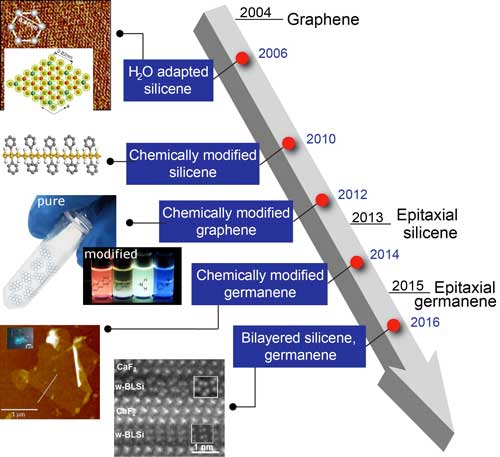|
NOVIDADES
Chemists are working to synthesize the next generation of super materials for high-performance electronics, solar cells, photodetectors and quantum computers. While they have made progress with compound materials, they have not yet succeeded in developing unaltered or “freestanding” materials for such devices, according to a review published in the journal Science and Technology of Advanced Materials ("Chemical modification of group IV graphene analogs").  Timeline for developing 2D materials similar to graphene. Image: NIMS
However, the tight lattice lacks a semiconducting bandgap, which is essential for electronic devices. Therefore, scientists have been hunting for alternative materials that have bandgaps, but still have a graphene-like structure. Much focus has been placed on graphene quantum dots, which are small segments of graphene, about 10 to 100 nm carbon hexagons across and less than 30 atomic sheets thick. To make the dots behave more like 2D graphene, research teams have added other molecules to change the structure and function of the material. For example, one team attached molecular groups containing nitrogen to graphene quantum dots. They found that different molecular combinations altered the electronic structure of the quantum dot in unique ways. This shifted the color of light the material produced when exposed to electricity, which is useful for light emitting diodes and photodetectors. Several teams have built and tested photodetectors using graphene quantum dots with success. The material has also been shown to improve the performance of dye-sensitized solar cells. Researchers are also investigating silicon and germanium analogs of graphene, called silicene and germanene, and their respective hydrogenated forms, silicane and germanane. They are testing how different preparation methods and structures, such as multiple layers and added molecules, affect performance for potential electronic or photonic devices. While silicene and germanene have not been prepared without added molecules so far, the modified materials strongly resemble the 2D materials theoretically predicted. Understanding the properties of the modified materials is a “good starting point” for developing future nanomaterials, according to the paper authors. Ultimately, the reviewers, led by Hideyuki Nakano of Toyota Central R&D Labs in Japan, are optimistic that electronic devices and energy storage materials could be developed using these materials in the near future. National Institute for Materials Science. Posted: Feb 01, 2018. |
|||||||||||||||||||||||||